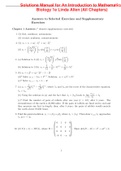(d)xt=/parenleftBigg
2√
3
3/parenrightBiggt/bracketleftbigg
c1sin/parenleftbiggπt
6/parenrightbigg
+c2cos/parenleftbiggπt
6/parenrightbigg/bracketrightbigg
4 (a) Solution to 3 (d) xt=/parenleftBigg
2√
3
3/parenrightBiggt
√
3 sin/parenleftbiggπt
6/parenrightbigg
(b) Solution to 3 (b) xt=5
12+5
8(−1)t+1+5
24(−5)t
5 (b) xt=c12t+c2(−2)t−1−2t
(d)* Solve xt+1−5xt= 5t+1.Solution: xt=c15t+t5t
(e)* Solve xt+1−xt= 1−4t
7 (a) xt=1√
5λt+1
1−1√
5λt+1
2, where λ1andλ2are the roots of the characteristic equation,
λ1> λ2.
(b) Using the solution in (a) and the fact that λ1>|λ2|leads to limt→∞xt+1
xt=λ1.
(c)* Find the number of pairs of rabbits after one year ( t= 12); after 5 years. The
circumference of the earth is 24,902 miles. If the pairs of rabbits are lined end to end and
they measure one foot in length, then, after 5 years, the pairs of rabbits would encircle
the earth about 19,050 times.
8 Find the general solution, xt=c1λt
1+c2λt
2, where λ1>|λ2|. Then show xt+1/xtapproaches
λ1ast→ ∞.
10 (2) Y(t+ 1) = BY(t),where B=
0 1 0 0
0 0 1 0
0 0 0 1
−b0−a0
.Show det( B−λI) =λ4+aλ2+b.
1Answers to Selected Exercises and Supplementary Exercises
Chapter 1 Answers (* denotes supplementary exercises)
1 (b) first, nonlinear, autonomous (d) second, nonlinear, nonautonomous
3 (b) xt = c1 + c2(−1)t + c3(−5) tSolutions Manual for An Introduction to Mathematical
Biology 1e Linda Allen (All Chapters) 11 (b) Y(t+ 1) = AY(t),A=
0 1 0
0 0 1
5 1−5
14ab < 1
15 (a) X(t) =c1
1
0
0
+c2(−3)t
3
0
−4
+c3(2)t
2
1
0
16At=
1 2t−1
0 2t
,X(t) =c1
1
0
+c22t
1
1
17 (a) λ3−3a2
4λ−a3
4= 0,λ=a,±a
2.R0=a2
4(a+ 3).
*Show R0>1 iffa >1.
(b) Apply Theorem 1.7.
19 (b) M2is reducible and imprimitive.
20 (a) Apply Theorem 1.7.
(b)R0=s1b2+s1s2b3= 1+2 s2is never less than one and is greater than one when s2>0.
*Let b2= 2, b3= 4 and s2= 2, then do part (b).
(c)R0= 1 + f2p1.
21 Apply Theorem 1.5 or Theorem 1.7.
22 (b) 0 ≤α <1, 0< α 2<1, 0< α 3≤1, and γ, σ > 0.
(c)R0=α1σγ+α2σ2γ(1−α1) +α3σ3(1−α1)(1−α2).
23 (b) L6>0.
(c) In Example 1.21 when s1is increased to one, λ≈0.965. When p7is increased to 0.95,
λ≈1.002.
25 (a) λ1=1−f+/radicalbig
(1−f)2+ 4γf
2>0,λ2=1−f−/radicalbig
(1−f)2+ 4γf
2<0.
(c) lim
t→∞Rt=R0+M0
1 +f.
26* Suppose Ais an n×nmatrix with a zero row or a zero column. Show that Ais reducible.
27* Suppose A= (aij) is an n×nirreducible matrix and A=D+B, where Dis a diagonal
matrix whose diagonal entries are equal to those of A,D=diag( a11, . . . , a nn). Show that B
is irreducible, i.e., the diagonal elements of an irreducible matrix do not affect irreducibility.
2 28* Suppose A= (aij) is an n×nnonnegative, irreducible matrix with one positive row, i.e.,
aij>0 for some iandj= 1, . . . , n . Show that A2has at least two positive rows, and in
general Ak,k≤nhas at least kpositive rows. Conclude that Ais primitive. ( Hint: Use
the results in Exercises 25 and 26.)
3




